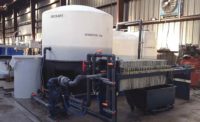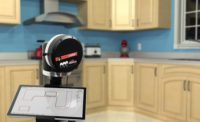With more than 25 years of experience in the industry, Brian Scherick, the vice president of sales for Flow International Corporation, discussed the benefits of waterjet technology in a podcast – elaborating on when it is best to use them and any maintenance requirements. Below is an excerpt from that podcast.
SW: What are some of the benefits of a waterjet?
BS: The benefit of a waterjet in general, regardless of its application, is its versatility. The ability to cut any material type. That’s the overarching benefit of the machine. I can go from cutting 3cm granite to a 2-inch-thick piece of steel to a piece of plastic. There is nothing really fundamentally different about the machine to do that. It’s just a matter of telling the machine through the computer, what material type, what thickness and what edge quality you want. That’s really a big benefit of a waterjet; its ability to cut any material.
In addition, especially comparing it to technology like a saw, which is linear direction cutting, it is omnidirectional cutting. So a waterjet is able to cut in any direction. It can cut very complex and intricate shapes.
SW: With a lot of the saws out there, you need a specific blade to cut the desired material. With waterjets, is there any difference in setup hardware-wise that you need? Or is it just software set up?
BS: 95% of the time it is a case where there is no change to the hardware. You know the cutting head, nozzle and the abrasives. Once the machine is set up for what you bought [it to do], for what you have, it’s essentially how it runs. With the different materials you are cutting, different thicknesses and different harnesses, the only thing that will fundamentally change is how fast you cut that. But you don’t really change much of the setup of the machine or a change to the hardware. It makes it very simple to run.
There are times you can tweak things. If you want to run a very fine mesh abrasive for an extremely smooth edge finish, you can do that. You are kind of playing on the fringes a little bit. For the most part, 95% of the time, it’s just the setup and then the cutting speed change.
SW: When cutting intricate details or curves, when does a situation like that come up for regular countertops. Such as the sink cut out?
BS: That’s exactly it. That’s a huge one. So undermount sinks, for example, when cutting that sink bowl with a waterjet is a fantastic application that can be done in a matter of minutes, and you’re done with that cut out. You can also do the plumbing holes for the faucets. In addition, any arches or curves in the countertop, if you wanted to incorporate that, is easy to do with a waterjet verses doing that with a saw or if you are trying to do an inside 90 degree. The waterjet is perfect for that sort of application where instead with a saw you have to stop short of that inside corner and then finish that some other way. So inside 90s are another big application.
PODCAST TITLE
PODCAST DESCRIPTION
SW: Other materials like porcelain and sintered materials are becoming extremely popular and with a saw they can be very difficult to cut. It seems like a solution we hear a lot is to go with a waterjet. Does using a waterjet for porcelain or other alternative stone materials make sense?
BS: It makes a lot of sense. Because, as you just mentioned, there are unique challenges when trying to use traditional tooling or saw blades to cut those types of engineered materials. Waterjet does a fantastic job. The general rule of thinking with a waterjet is the harder something is to process with traditional tools, the better of an application it is for a waterjet. We are an erosion process. We really don’t care what the material type is; it’s just a matter of how fast we can cut it. It will literally cut any material. As you get these very brittle or very fragile materials, it doesn’t make any difference to the erosion process of a waterjet, where it does make a difference if you are trying to use a traditional drill or saw on that type of material.








